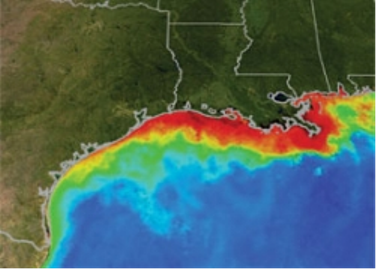A “dead zone” is an area of ocean that is so depleted of oxygen that no fish, marine mammals, or in some cases life of any kind, can live there. Dead zones exist all around the world, especially where major rivers dump industrial and agricultural runoff that may come from hundreds of miles away. Here in the US, the Mississippi River drains about a third of the country, so the pesticides, antibiotics, fertilizers, and manures produced by thousands of farms and ranches in many states end up in the Gulf of Mexico.
That was true even before last year’s catastrophic BP oil hemorrhage. So the waters of the gulf are not fit for a self-respecting fish to live in. The photo below shows the extent of this low-oxygen dead zone, with red areas being lowest.
Lindsey Blomberg reports in E Magazine that recovery from dead zone status is possible, stating:”Such a turnaround has been seen in the Black Sea, which contained the largest dead zone in the world during the 1980s. Following the collapse of the Soviet Union, fertilizers became too costly to use. Phosphorus applications were cut by 60% and nitrogen use was halved. By 1996, the dead zone was absent for the first time in 23 years.”
What can you do? Choose more organically produced foods of all kinds. This causes less harm to human health air, land, and water – including oceans. Eat less beef (better yet – none), because producing it creates tons of runoff that poisons oceans.
Oh by the way, if you do think you’d like to eat seafood, would you really want it to come from an area of ocean that is, frankly, our nation’s sewer system?

